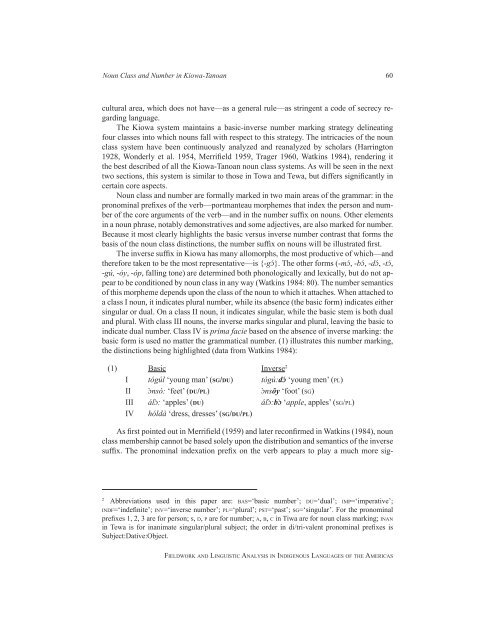Fieldwork and Linguistic Analysis in Indigenous ... - ScholarSpace
Fieldwork and Linguistic Analysis in Indigenous ... - ScholarSpace
Fieldwork and Linguistic Analysis in Indigenous ... - ScholarSpace
Create successful ePaper yourself
Turn your PDF publications into a flip-book with our unique Google optimized e-Paper software.
Noun Class <strong>and</strong> Number <strong>in</strong> Kiowa-Tanoan 60<br />
cultural area, which does not have—as a general rule—as str<strong>in</strong>gent a code of secrecy regard<strong>in</strong>g<br />
language.<br />
The Kiowa system ma<strong>in</strong>ta<strong>in</strong>s a basic-<strong>in</strong>verse number mark<strong>in</strong>g strategy del<strong>in</strong>eat<strong>in</strong>g<br />
four classes <strong>in</strong>to which nouns fall with respect to this strategy. The <strong>in</strong>tricacies of the noun<br />
class system have been cont<strong>in</strong>uously analyzed <strong>and</strong> reanalyzed by scholars (Harr<strong>in</strong>gton<br />
1928, Wonderly et al. 1954, Merrifield 1959, Trager 1960, Watk<strong>in</strong>s 1984), render<strong>in</strong>g it<br />
the best described of all the Kiowa-Tanoan noun class systems. As will be seen <strong>in</strong> the next<br />
two sections, this system is similar to those <strong>in</strong> Towa <strong>and</strong> Tewa, but differs significantly <strong>in</strong><br />
certa<strong>in</strong> core aspects.<br />
Noun class <strong>and</strong> number are formally marked <strong>in</strong> two ma<strong>in</strong> areas of the grammar: <strong>in</strong> the<br />
pronom<strong>in</strong>al prefixes of the verb—portmanteau morphemes that <strong>in</strong>dex the person <strong>and</strong> number<br />
of the core arguments of the verb—<strong>and</strong> <strong>in</strong> the number suffix on nouns. Other elements<br />
<strong>in</strong> a noun phrase, notably demonstratives <strong>and</strong> some adjectives, are also marked for number.<br />
Because it most clearly highlights the basic versus <strong>in</strong>verse number contrast that forms the<br />
basis of the noun class dist<strong>in</strong>ctions, the number suffix on nouns will be illustrated first.<br />
The <strong>in</strong>verse suffix <strong>in</strong> Kiowa has many allomorphs, the most productive of which—<strong>and</strong><br />
therefore taken to be the most representative—is {-gɔ́}. The other forms (-mɔ́, -bɔ́, -dɔ́, -tɔ́,<br />
-gú, -óy, -óp, fall<strong>in</strong>g tone) are determ<strong>in</strong>ed both phonologically <strong>and</strong> lexically, but do not appear<br />
to be conditioned by noun class <strong>in</strong> any way (Watk<strong>in</strong>s 1984: 80). The number semantics<br />
of this morpheme depends upon the class of the noun to which it attaches. When attached to<br />
a class I noun, it <strong>in</strong>dicates plural number, while its absence (the basic form) <strong>in</strong>dicates either<br />
s<strong>in</strong>gular or dual. On a class II noun, it <strong>in</strong>dicates s<strong>in</strong>gular, while the basic stem is both dual<br />
<strong>and</strong> plural. With class III nouns, the <strong>in</strong>verse marks s<strong>in</strong>gular <strong>and</strong> plural, leav<strong>in</strong>g the basic to<br />
<strong>in</strong>dicate dual number. Class IV is prima facie based on the absence of <strong>in</strong>verse mark<strong>in</strong>g: the<br />
basic form is used no matter the grammatical number. (1) illustrates this number mark<strong>in</strong>g,<br />
the dist<strong>in</strong>ctions be<strong>in</strong>g highlighted (data from Watk<strong>in</strong>s 1984):<br />
(1) Basic Inverse 2<br />
I tógúl ‘young man’ (SG/DU) tógú:dɔ́ ‘young men’ (Pl)<br />
II ɔ̀nsó: ‘feet’ (DU/PL) ɔ̀nsôy ‘foot’ (sg)<br />
III álɔ̀: ‘apples’ (DU) álɔ̀:bɔ̀ ‘apple, apples’ (sg/Pl)<br />
IV hóldà ‘dress, dresses’ (SG/DU/PL)<br />
As first po<strong>in</strong>ted out <strong>in</strong> Merrifield (1959) <strong>and</strong> later reconfirmed <strong>in</strong> Watk<strong>in</strong>s (1984), noun<br />
class membership cannot be based solely upon the distribution <strong>and</strong> semantics of the <strong>in</strong>verse<br />
suffix. The pronom<strong>in</strong>al <strong>in</strong>dexation prefix on the verb appears to play a much more sig-<br />
2 Abbreviations used <strong>in</strong> this paper are: bas=‘basic number’; du=‘dual’; imP=‘imperative’;<br />
<strong>in</strong>df=‘<strong>in</strong>def<strong>in</strong>ite’; <strong>in</strong>v=‘<strong>in</strong>verse number’; Pl=‘plural’; Pst=‘past’; sg=‘s<strong>in</strong>gular’. For the pronom<strong>in</strong>al<br />
prefixes 1, 2, 3 are for person; s, d, P are for number; a, b, c <strong>in</strong> Tiwa are for noun class mark<strong>in</strong>g; <strong>in</strong>an<br />
<strong>in</strong> Tewa is for <strong>in</strong>animate s<strong>in</strong>gular/plural subject; the order <strong>in</strong> di/tri-valent pronom<strong>in</strong>al prefixes is<br />
Subject:Dative:Object.<br />
fieldwork <strong>and</strong> l<strong>in</strong>guistic analysis <strong>in</strong> <strong>in</strong>digenous languages of the americas

















